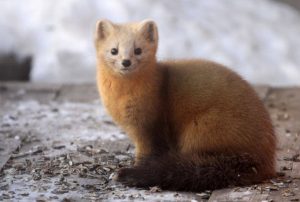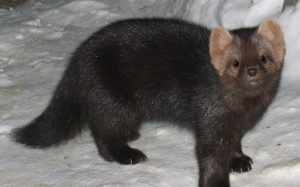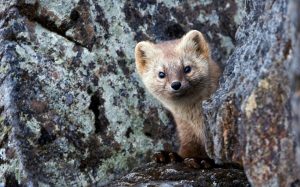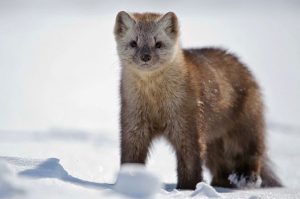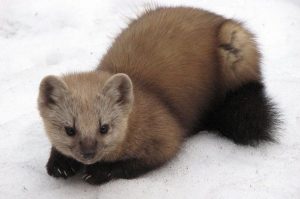Sable: Stealthy Forest Predator with Unique Hunting Skills
Deep in the shadowy forests, a figure moves through the underbrush with ghostly silence. The Sable—sleek, elusive, and fiercely intelligent—glides through its environment, its sharp senses and stealthy movements making it one of the forest’s most skilled predators. With a blend of power, precision, and agility, the Sable remains a mystery to many, embodying the raw beauty and intensity of nature’s quieter moments.
The Mysterious Sable Predator
The Sable is a predator of unmatched skill, its sleek form built for silent movement through dense, temperate forests. Native to parts of Russia, Mongolia, and other parts of Asia, the Sable has earned a reputation as a master hunter. Despite its small size, the Sable is a force in the forest, using its quick reflexes, acute hearing, and stealth to catch its prey. Known for its thick, dark fur that provides both warmth and camouflage, the Sable has survived centuries in harsh environments. Its elegance and ferocity make it a compelling figure in the wild, one that represents both the mystery and power of the natural world.
The Sable is paradox of an animal being quite ferocious in the wild, but able to be well-tamed when kept as a pet. This hunter has also been hunted since time immemorial; prized for its skin and fur.
Scientific Classification
| Kingdom | Animalia |
| Phylum | Chordata |
| Class | Mammalia |
| Order | Carnivora |
| Family | Mustelidae |
| Genus | Martes |
| Scientific Name | Martes zibellina |
Physical Characteristics: Sleek and Stealthy
The Sable is built for speed and stealth. Males grow to a body length of 15-22 inches (38-55 cm), with tails that extend up to 4.7 inches (12 cm), providing balance and aiding in swift movements. Its fur, which ranges from deep brown to near-black, is not just beautiful but functional—dense and glossy, it helps it blend into its environment as it moves silently through the trees. This predator’s sharp claws and slender body allow it to maneuver through the underbrush and trees, navigating its habitat with effortless agility. The Sable’s fur is prized for its luxurious texture, often sought after, but it is the predator’s movement that truly captivates the imagination—every step calculated, every movement deliberate.
- Size: Males measure 15-22 inches (38.1-55.88 cm) in body length, with females being slightly smaller.
- Tail: Males have tails measuring 3.5-4.7 inches (8.89-11.9 cm), while females’ tails are slightly shorter.
- Weight: Males weigh between 28-63.49 oz (0.7-1.7 kg), while females are lighter.
- Color: Their fur ranges from brown to black, with pale yellow, white, or gray markings.
- Lifespan: Sables live 18-20 years in the wild.
These features allow the Sable to move quickly and quietly through its environment, hunting and avoiding predators with equal efficiency.
Quick Information
| Description | Size: Males are 15-22 in (38.1-55.88 cm) and females are 14-20 in (35.56-50.8 cm). The tail in males is 3.5-4.7 in (8.89-11.9 cm) while females’ tail is 2.8-4.5 in (7.1-11.43 cm) Weight: Males are 28-63.49 oz (0.7-1.7 kg) and women are less heavier than them Color: Brown to black body with individuals showcasing some pale yellow, white, or gray marks |
| Distribution | Russia, China, Mongolia, Japan, and Korea |
| Habitat | Mountains, flatlands, and deep forest |
| Lifespan | 18-20 years |
| Diet | Birds, small mammals, fish, eggs, and plants |
| Adaptations | 1. They have a good hearing ability that enables them to locate where their potential preys are 2. They can stealthily move around, due to their light steps and flexible body |
| Predators | Eagles, foxes, wolves, eagles, wolverines, large owls and lynxes |
| IUCN Conservation Status | Least Concern |
Diet and Hunting: The Stealthy Predator’s Strategy
The Sable is a carnivore with a refined hunting strategy. It is both patient and precise, waiting for the perfect moment to pounce on its prey, which ranges from small mammals to birds and eggs. What makes the Sable a remarkable predator is its ability to stalk its prey with complete stealth. Using its sharp senses of sight and hearing, it tracks even the slightest movement in the underbrush. Its hunting time often coincides with dusk or dawn, when the world is quieter and its prey is less alert. In these moments, the Sable becomes an almost invisible figure, gliding through the forest like a shadow, before it strikes with precision. Its sharp claws and keen reflexes make it a formidable predator, while its ability to cache food ensures it is well-prepared for times of scarcity.
- Diet: Includes birds, small mammals, fish, eggs, and even some plants.
- Hunting Skills: The Sable is known for its stealth and agility, using its acute hearing to locate prey. It often hunts during the twilight hours, using the cover of dusk to stalk its prey.
- Adaptations: The Sable’s sharp claws, long body, and keen sense of hearing make it a formidable hunter. Its stealthy movements and quick reflexes help it avoid detection while on the prowl.
The Sable often caches food for the winter, storing prey when hunting is tough. It also tracks other predators to feed on leftovers, making it an efficient scavenger as well.
Territorial Behavior: Marking and Defending Its Domain
The Sable is fiercely territorial, and it will go to great lengths to protect its hunting grounds. Using scent-marking to assert its dominance, it marks trees, rocks, and other structures in its territory. The Sable’s home range can span several square miles, and it will defend it aggressively against other predators, including fellow Sables. This territoriality is essential for survival, as it ensures access to the resources it needs—food, shelter, and mates. Male Sables are particularly aggressive when competing for the attention of females, engaging in intense and often brutal fights. These skirmishes, while brief, demonstrate the fierce determination of the Sable, a creature whose will to survive is matched only by its tenacity.
- Territory: Sables mark their territory using scent glands found in their abdomen.
- Behavior: They are active primarily at twilight and often travel alone, except during mating season. Their territory can span several square kilometers, and they will defend it from other sables or potential intruders.
- Conflict: Male sables often engage in fights with each other for access to females, using their agility and quick reflexes to gain dominance.
The Sable‘s territorial nature ensures it has exclusive access to the vital resources in its environment.
Reproduction and Life Cycle: A Careful Mating Strategy
The Sable has a slow reproductive cycle, with mating occurring during the winter months. Males compete fiercely for access to females, marking their territory and engaging in combat to prove their dominance. Once a female mates, she will give birth after a gestation period of about 9 months. Litters typically consist of 1-7 pups, which are born blind and hairless. Over the next few months, the pups grow rapidly, with their eyes opening after a few weeks. By the time they are weaned, the pups are well on their way to becoming capable hunters themselves, learning the stealthy skills needed to survive in the wild. Though their chances of survival are low during their first year—only 15-25% make it past this stage—the young Sable will learn quickly, developing the hunting and territorial behaviors necessary to thrive.
The mating season for the Sable begins in June and lasts through mid-August.
- Mating: Males compete for females, often fighting fiercely. During courtship, males will jump and run with enthusiasm, digging burrows and urinating inside to attract females.
- Gestation: The Sable’s gestation period lasts between 245-298 days, and after birth, the female gives birth to 1-7 pups.
- Pups: At birth, the pups weigh just 0.88-1.23 oz (24.9-34.8 g) and are covered in fine hair. They open their eyes after 30-36 days and begin to venture outside the nest. By 2 years of age, they reach sexual maturity.
The slow reproductive cycle of the Sable reflects the challenges it faces in its environment, but it is highly adapted to protect and nurture its young.
Life-cycle
Newborn sables weigh around 0.88-1.23 oz (24.9-34.8 g), completely covered with thin hair. They are blind at birth but open their eyes after 30-36 days. Around this time, they start to move out of the nest and get weaned by mothers. They attain sexual maturity around 2 years old.
Conservation and Challenges: Protecting a Stealthy Predator
While the Sable is classified as “Least Concern” by the IUCN, its populations are not without threat. Habitat destruction and deforestation have caused a loss of suitable environments for the Sable to thrive in. In addition to this, illegal hunting for its fur has led to a decline in numbers in certain areas. Although resilient, the Sable’s survival is deeply tied to the health of the forests it inhabits. Conservation efforts focus on preserving these habitats and preventing further damage from human activities. Sustainable hunting practices and reforestation projects are crucial in ensuring that the Sable’s natural habitat remains intact for generations to come.
- Habitat Loss: Deforestation and habitat destruction are ongoing threats to the Sable, as it depends on dense, mature forests.
- Predators and Competition: While the Sable is a skilled hunter, it faces competition from other carnivores, including foxes, wolves, and wolverines.
- Conservation: Efforts to protect the Sable focus on preserving forest habitats and managing human impacts in the regions where it lives.
The Sable‘s stealth and adaptability have allowed it to survive for generations, but conservation efforts are crucial to its future.
Interesting Facts
- The species is often crossed with pine martens and the new breed is known as Kidus.
Summary: A Stealthy Predator with Incredible Adaptability
The Sable is one of the forest’s most fascinating predators. Its remarkable stealth, agility, and hunting prowess have made it a master of survival. While it faces threats from habitat loss and competition, the Sable continues to thrive in remote, forested areas. Its territorial nature and strategic hunting methods ensure it remains a vital part of its ecosystem, maintaining the delicate balance of the forest floor.
References:
- https://www.worldatlas.com/articles/sable-facts-animals-of-asia.html
- https://a-z-animals.com/animals/sable/
- https://www.science.smith.edu/departments/Biology/VHAYSSEN/msi/pdf/876.1.pdf
Published on April 22nd 2019 by Sahana Kanjilal under Coniferous Forest Animals.
Article was last reviewed on 9th December 2024.


